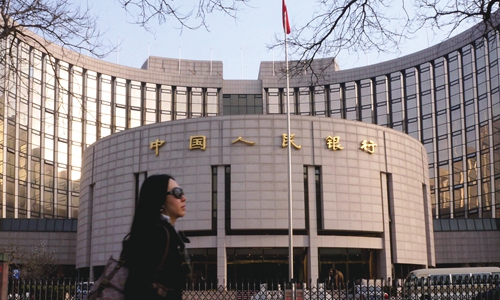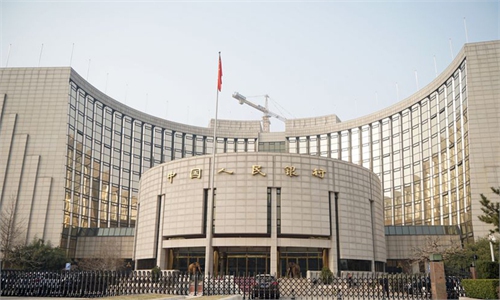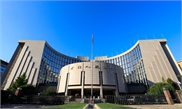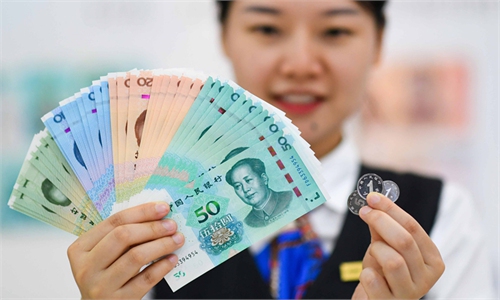
The building of the People's Bank of China in Beijing Photo: VCG
China will open its monetary policy toolbox wider to maintain the stability of total credit, Liu Guoqiang, a deputy governor of the People's Bank of China (PBC), the country's central bank, said on Tuesday, vowing to roll out more pro-stability policies until the downward pressure on the economy is fundamentally eased.
In addition to keeping total credit stable and avoiding the collapse of credit, the central bank's policy efforts will also include targeted and forward-looking moves to "get ahead of the curve and respond promptly to general concerns of the market," Liu told reporters at a press conference in Beijing.
In a fresh easing move, the PBC on Monday lowered the rate on seven-day reverse repurchase agreements by 10 basis points (bps) to 2.1 percent and cut the interest rate on the one-year medium-term lending facility (MLF) to 2.85 percent from 2.95 percent.
The reduction in the two key policy rates was the first in about two years.
Moreover, according to Liu, commercial banks will submit optimal quotations for the loan prime rate (LPR) on Thursday.
The LPR, the de facto benchmark lending rate, is updated on the 20th of every month, which falls on Thursday this time.
The LPR will fully reflect market rate changes in a timely manner, guide down corporate borrowing rates and push for reduced financing costs for businesses, Sun Guofeng, head of the PBC's monetary policy department, said at the same press conference.
Monetary policy revisions that have begun in major developed economies would have a limited impact on China, Sun remarked, pointing to China's macroeconomic resilience, the use of normal monetary policies since the advent of the COVID-19 epidemic, and steady expectations for the yuan's exchange rate.
The PBC officials' remarks stoked speculation over a cut in the one-year LPR, which was trimmed by 5 bps in December.
In the wake of the MLF rate cut, the LPR is expected to trend lower, according to Da Min, director of client solutions investment at Fidelity International.
Beyond that, the government is expected to take advantage of policy easing to revitalize infrastructure investment and stabilize real estate investment, Da said in a note sent to the Global Times, adding that a new package of stimulus plans won't be confined to monetary policy.
Da cited local moves to lower mortgage loan rates and the approval of certain infrastructure projects by the National Development and Reform Commission. Such measures will bolster credit demand and stabilize growth.
Meanwhile, as Liu pointed out, the central bank has diminished leeway to further cut banks' reserve requirement ratios (RRRs), following two 50-bps universal RRR cuts in July and December, which together released long-term liquidity of 2.2 trillion yuan ($346.33 billion).
After the two reductions, the average RRR ratio at financial institutions now stands at 8.4 percent, lower than in other developing economies and also lower compared with the country's previous levels.
China's macro-policy easing will advance in early 2022, according to Andrew Fennell, senior director of Asia-Pacific Sovereigns at Fitch Ratings.
Fennell wrote in a research report sent to the Global Times on Tuesday that "this will include a cut of the policy rate, albeit symbolic, accompanied by a modest acceleration in credit growth."
He noted that "widespread property-sector and financial-contagion risks should be averted, as strategic adjustments to macro-financial regulations stabilize market confidence and refinancing conditions."



